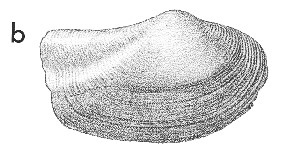
Revised descriptions of New Zealand Cenozoic Mollusca from Beu and Maxwell (1990)

 | Revised descriptions of New Zealand Cenozoic Mollusca from Beu and Maxwell (1990) | 
|
  (Pl. 28b): holotype, GS1125, Q18/f9020, coast between Waikiekie and Maungapukatea streams, North Taranaki, Tongaporutuan (TM4091, GNS) |
Beu & Maxwell (1990): Chapter 13; p. 254; pl. 28 b.
Synonymy: Neilo sublaevis Marwick 1926c, p. 329
Classification: Malletiidae
Description: Large for family (25 to 57 mm long; largest New Zealand malletiid), long and moderately narrow, with dorsal and ventral margins both lightly down-curved, subparallel; anterior end evenly rounded, posterior end markedly longer than anterior, drawn out into weakly sinuate rostrum (variable in length and protrusion); umbo at anterior 0.3-0.4 of length. Low ridge extending from umbo to postero-ventral margin, marking off posterior area. Sculpture of weak, rather irregular commarginal ridges and grooves on posterior area and, more weakly, on anterior end; most specimens almost completely smooth medially. Margins smooth. Hinge thick, with many similar, shallowly V-shaped teeth; about 22 posterior and 30 anterior teeth in shell 43 mm long. Adductor scars small, deeply impressed; pallial sinus deeply U-shaped, directed slightly downward anteriorly, extending only to posterior third of length.
Comparison: The very large size for a New Zealand malletiid, the thick shell, and the largely smooth and, in many specimens, lightly polished exterior make Neilo sublaevis easily recognised.
Marshall (1978b) showed that Neilo sublaevis differs little from its presumed descendant N. annectens (= N. rugata Dell, 1956) (Opoitian-Recent), the older species having a slightly thicker shell and consequently a wider hinge plate than the younger one. N. annectens occurs now in water 100-700 m deep (Marshall 1978b) and this provides good corroborating evidence for the ecology of the fossils, which occur widely but uncommonly in siltstone with sparse Mollusca. However, Marshall (1978b) also showed that N. annectens occurred in shallower water during cool periods than during warm periods and, for example, is not uncommon in shelf assemblages with common Mollusca in the Kai-Iwi and Okehu Groups in the Castlecliffian type section, Wanganui, deposited in about 50-60 m of water.
The shallow-water species Neilo australis is the most common Neilo species in Nukumaruan to Recent faunas, and is easily distinguished from N. annectens by its smaller size, its thinner shell, and its sculpture of regular, thin, commarginal lamellae. N. australis occurs commonly in inner to mid-shelf siltstone in Wanganui, Hawke's Bay, and Wairarapa.
Distribution: Clifdenian-Kapitean; fairly common, North Taranaki coast, Tongaporutuan (type); widespread in North Taranaki, Gisborne district, southern Wairarapa and North Canterbury, in siltstone of outer shelf and upper bathyal facies.
Cite this publication as: "A.G. Beu and J.I. Raine (2009). Revised
descriptions of New Zealand Cenozoic Mollusca from Beu and Maxwell (1990). GNS
Science miscellaneous series no. 27."
© GNS Science, 2009
ISBN
978-0-478-19705-1
ISSN 1177-2441
(Included with a PDF facsimile file
copy of New Zealand Geological Survey Paleontological Bulletin 58 in CD version
from: Publications Officer, GNS Science, P.O. Box 30368 Lower Hutt, New
Zealand)